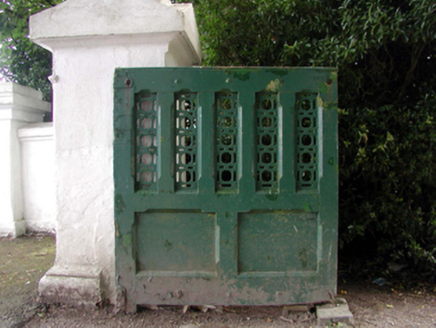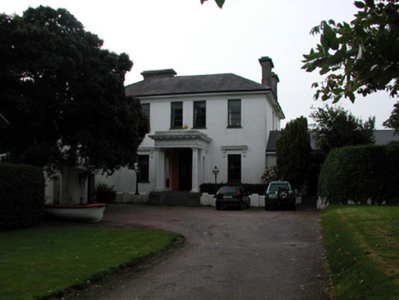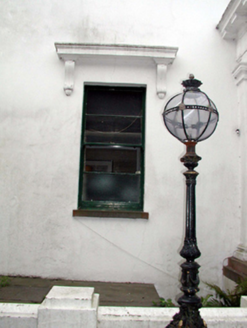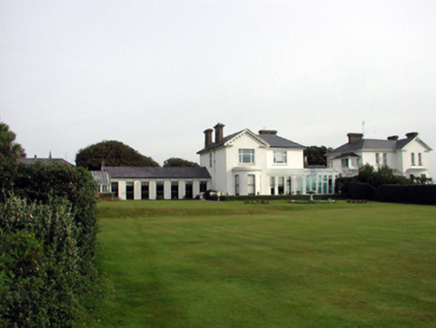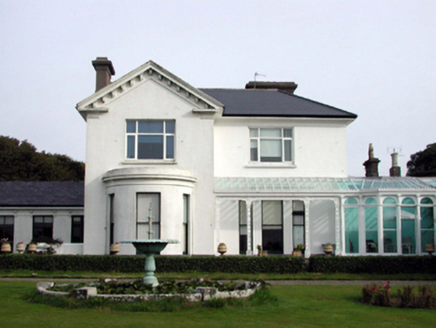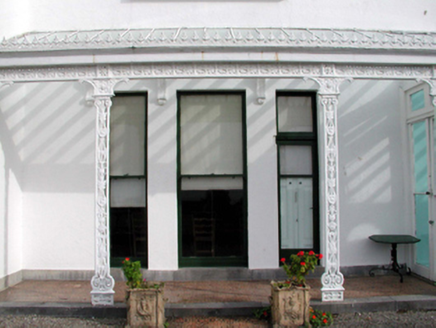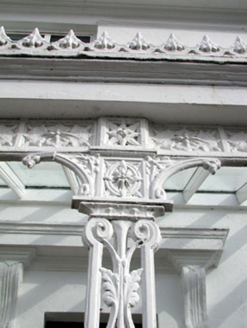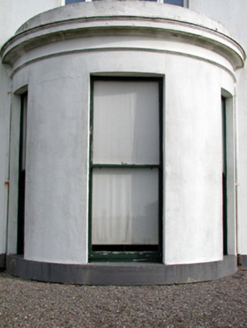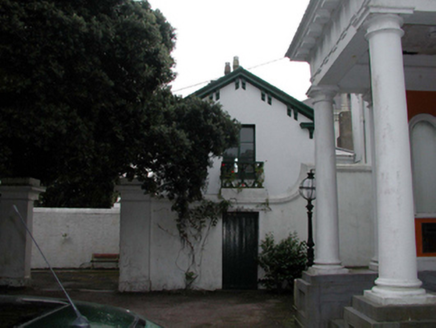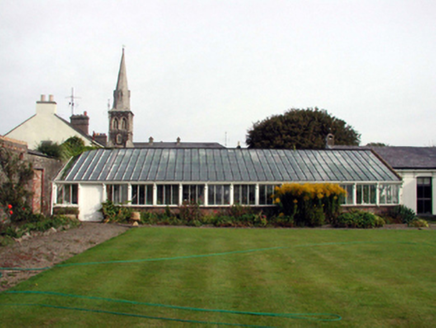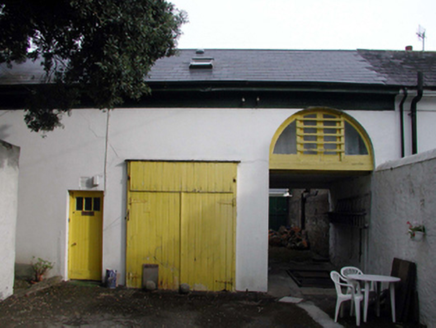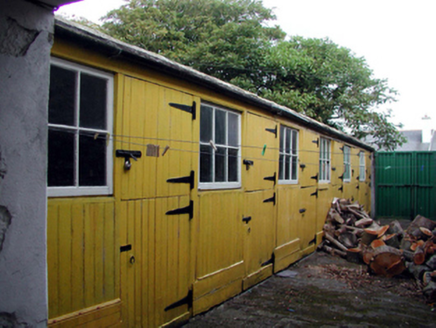Survey Data
Reg No
22816169
Rating
Regional
Categories of Special Interest
Architectural, Artistic
Original Use
House
In Use As
House
Date
1850 - 1870
Coordinates
257897, 100943
Date Recorded
12/09/2003
Date Updated
--/--/--
Description
Semi-detached three-bay two-storey over basement house, c.1860, retaining most original fenestration with single-bay single-storey flat-roofed projecting open Doric porch to centre, two-bay two-storey side elevation to east, and two-bay two-storey Garden elevation to south having single-bay two-storey gabled projecting bay to left with single-bay single-storey bowed bay window to ground floor, single-bay single-storey lean-to veranda to right ground floor, and single-bay single-storey conservatory to south-east having single-bay single-storey canted bay. Reroofed and extended, c.1985, comprising seven-bay single-storey perpendicular wing to west. Part refenestrated, pre-1999, with some openings remodelled. One of a pair. Hipped double-pile (M-profile) roof (pitched to projecting bay to Garden (south) elevation; pitched to additional wing) with replacement artificial slate, c.1985, clay ridge tiles, rendered chimney stacks, and replacement aluminium rainwater goods, c.1985, on overhanging timber eaves (forming open-bed pediment to projecting bay with consoles). Flat roof to porch not visible behind parapet. Lean-to glazed roof to verandas in cast-iron frames with eaves having decorative cast-iron cresting, and pitched glazed roof to conservatory (half-polygonal to canted section) in cast-iron frame with zinc-lined ridges, and coping. Painted rendered walls with rendered band to eaves, and rendered dressings to porch including triglyph frieze having modillion cornice over, and blocking course to parapet. Square-headed window openings (some remodelled, pre-1999, to Garden (south) elevation) with cut-stone sills, and some with moulded entablatures over to ground floor on consoles. 2/2 timber sash windows to front (north) elevation with horizontal bias to glazing pattern, and 1/1 timber sash windows to remainder with replacement uPVC casement windows, pre-1999, to remodelled openings. Square-headed door opening to porch approached by flight of seven cut-limestone steps having pedestals supporting Doric columns, glazed timber panelled doors, and overlight. Square-headed openings to veranda with decorative cast-iron panel piers supporting decorative cast-iron aprons. Square-headed openings to conservatory with fixed-pane iron windows having round-headed panes. Series of seven square-headed openings to additional wing with fixed-pane aluminium fittings, and some having glazed aluminium double doors. Interior with timber panelled shutters to window openings. Set back from road in own grounds with landscaped grounds to site, and random rubble stone boundary wall to perimeter having stone cobbled coping. (ii) Attached single-bay single-storey gable-fronted service block with half-dormer attic, c.1860, to north-east retaining some original fenestration with three-bay single-storey side (north) elevation. Reroofed and renovated, pre-1999, with some openings remodelled. Pitched (gable-fronted) roof with replacement artificial slate, pre-1999, clay ridge tiles, rendered (shared) chimney stack, replacement square rooflights, pre-1999, and replacement uPVC rainwater goods, pre-1999, on overhanging rendered eaves forming open-bed pediment to gable with consoles. Painted rendered walls. Square-headed window openings (remodelled, pre-1999, to side (north) elevation) with stone sills (replacement concrete sill, pre-1999, to remodelled opening). Timber casement windows with replacement timber casement windows, pre-1999, to remodelled openings. Square-headed door openings (one additional, pre-1999, to side (north) elevation) with tongue-and-groove timber panelled doors. (iii) Detached fourteen-bay single-storey mono-pitched glasshouse, c.1860, to west retaining original aspect. Mono-pitched glazed roof in cast-iron frame with rendered coping having decorative cast-iron cresting, and cast-iron rainwater goods. Red brick English Garden Wall bond walls. Square-headed window openings with stone sills, and fixed-pane windows having intermediary piers with consoles. Square-headed door openings with timber panelled doors. (iv) Detached three-bay single-storey coach house/stable block with half-attic, c.1860, to north-east on a T-shaped plan with pair of square-headed carriageways to right ground floor, and eleven-bay single-storey perpendicular wing to north. Reroofed and renovated, pre-1999. Pitched roofs with replacement artificial slate, c.1995, clay ridge tiles, replacement square rooflights, pre-1999, and cast-iron rainwater goods on overhanging timber eaves. Painted rendered walls. Square-headed door opening with glazed tongue-and-groove timber panelled door. Square-headed carriageway with tongue-and-groove timber panelled double doors. Square-headed carriageway to right ground floor with no fittings, and lunette window opening having timber casement windows with louvered protective fitting, and fixed-pane sidelights. Square-headed openings to perpendicular wing with tongue-and-groove timber panelled half-doors, and fixed-pane timber windows on tongue-and-groove timber panels. (v) Gateway, c.1860, to north comprising pair of painted rendered piers with profiled capping, timber panelled double gates, painted rendered curved flanking walls, and painted rendered terminating piers with profiled capping.
Appraisal
A very fine substantial house, built as one of a pair (with 22816168/WD-26-16-168), which has been well maintained to present an early aspect, with important salient features and materials intact, both to the exterior and to the interior. The complex massing and inventive features, such as the arrangement of openings, the use of a bowed bay window and so on, all serve to enhance the architectural value of the site. Finely detailed throughout, the house incorporates fine cast-iron work that augments the artistic design quality of the site. Important survivals include the original service block, the glass house and the coach house/stable block complex, which have been carefully planned as integral components of the estate, and which augment the importance of the site. The house, together with the second in the pair, forms an important component of the architectural heritage of Tramore and, positioned overlooking Tramore Bay, attests to the development of the locality as a Victorian seaside resort in the mid to late nineteenth century.
